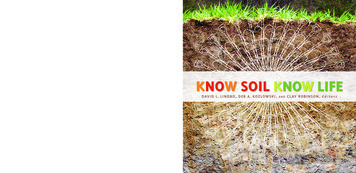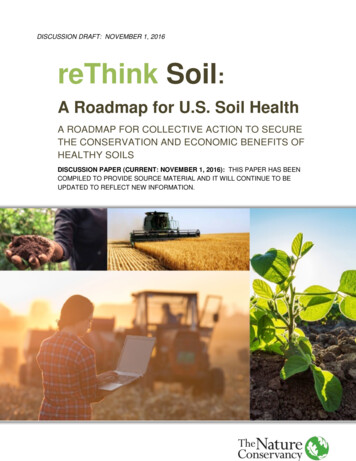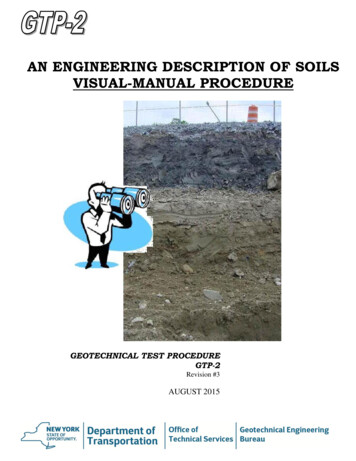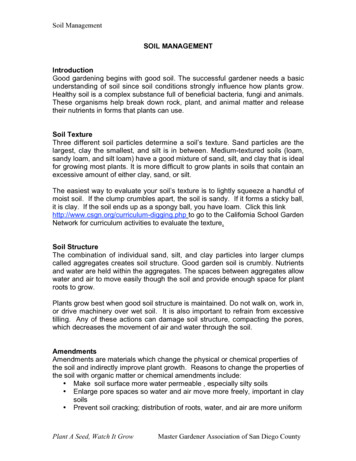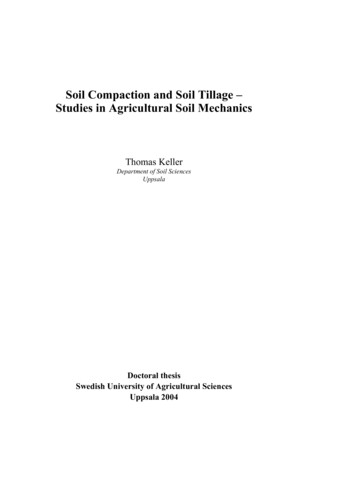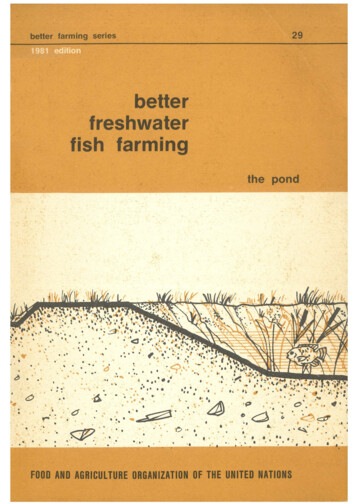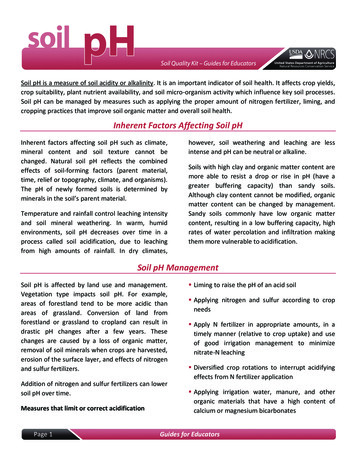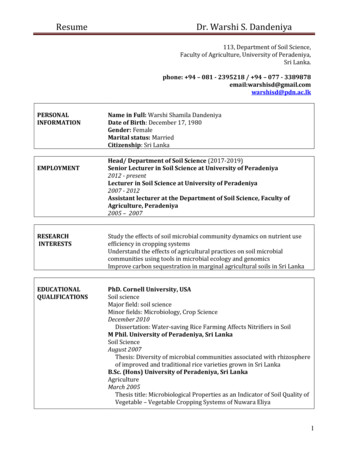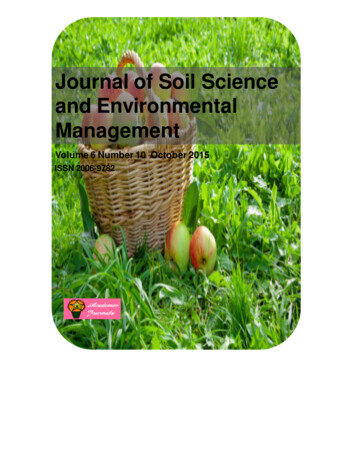
Transcription
Journal of Soil Scienceand EnvironmentalManagementVolume 6 Number 10 October 2015ISSN 2006-9782Soil4 Number 6ISSN 2141-2391October 2013
ABOUT JSSEMThe Journal of Soil Science and Environmental Management (JSSEM) is published monthly (one volume peryear) by Academic Journals.Journal of Soil Science and Environmental Management (JSSEM) is an open access journal that provides rapidpublication (monthly) of articles in all areas of the subject such as Biological control of rot-inducing fungi, Postharvest losses of rice from harvesting to milling, Genetic variability studies between released varieties ofcassava, Seed borne pathogens on farmer-saved sorghum etc.The Journal welcomes the submission of manuscripts that meet the general criteria of significance andscientific excellence. Papers will be published shortly after acceptance. All articles published in JSSEM are peerreviewed.Contact UsEditorial Office:jssem@academicjournals.orgHelp ww.academicjournals.org/journal/AJARSubmit manuscript onlinehttp://ms.academicjournals.me/
EditorsDr. Willie PeijnenburgRIVM – Laboratory for Ecological Risk assessmentLeiden University, Centre for EnvironmentalsciencesBilthoven,The Netherlands.Prof. Gamal Abdel-Nasser KhalilSoil Science Dept.College of Food and Agricultural Sciences - King SaudUniversityP.O. BOX 2460 - Riyadh 11451,Saudi Arabia.Dr. Geoffrey KironchiDepartment of Land Resource Management &Agricultural TechnologyUniversity of Nairobi,Kenya.Dr. Anil vyasDepartment of Botany,J.N.V. UniversityA-282, Shastri Nagar.
Editorial BoardDr. Elijah OhimainNorth Carolina A & T State University, GreensboroCarver Hall Room 207,Department of Natural Resources andEnvironmental Design,School of Agriculture and Environmental Science,USA.Dr. Mohamed Rashad Abd El-FattahArid Lands Cultivation and Development ResearchInstitute,Mubarak City for Scientific Research andTechnology Applications,Egypt.Dr. Gamal Abdel-Nasser KhalilKing Saud University P.O. BOX 2460 – Riyadh11451,Saudi Arabia.Dr. V. Krishna MurthyPes Institute of Technology,Ring Road, BSK III Stage, Bangalore-560 085,Karnataka State,India.Dr. ANIL VYASDepartment of Botany,J. N. V. University, A-282, Shastrinagar,India.Dr. Anthony O. AnoNational Roots and Tubers Research InstituteUmudike, Umuahia, Abia State,Nigeria.Dr Moacir de Souza Dias JuniorUniversidade Federal de Lavras (Federal Universityof Lavras)Departamento de Ciência do Solo (Soil ScienceDepartment)Brazil.Dr. Luki SubehiNdonesian Institute of Sciences,Research Centre for LimnologyCibinong Science Centre 16911 Indonesia.Dr. Goswami ShreerupP.G. Department of Environmental Science,F.M. University , Gyana Vigyana Vihar,Balasore-756020, Orissa,India.Dr. Tanushree BhattacharyaInstitute of Science and Technology for AdvancedStudies & ResearchISTAR, Near V.P. Science College, Motabazar, VallabhVidyanagar,Anand, Gujarat 388120"India.Dr. Suklayan ChakrabortyV. Patel College of Pure and Applied Scienes,India.Dr. Ulviyya SamadovaInstitute of Soil science and Agrochemistry ofAzerbaijan National,Azerbaijan.Dr. Luís Carlos TimmFederal University of PelotasAddress Campus Universitário s/n – Capão do LeãoRS,Brazil.Dr. Willie PeijnenburgRIVM – Laboratory for Ecological Risk assessmentLeiden University, Centre for Environmental sciencesBilthoven,The Netherlands.Dr. Dedeke Gabriel AdewumiUniversity of Agriculture, Abeokuta, Ogun State,Nigeria.Dr. M J SinghPunjab Agricultural University, PunjabIndia.Mr. WillisUniversity of Western AustraliaAustralia.
Journal of Soil Science and Environmental ManagementTable of Contents:Volume 6Number 10 October 2015ARTICLESResearch ArticlesEffects of integrating different soil and water conservation measures intohillside area closure on selected soil properties in Hawassa Zuria District,EthiopiaLemma Tiki, Menfes Tadesse and Fantaw Yimer268Effect of lime and goat manure on soil acidity and maize (Zea mays) growthparameters at Kavutiri, Embu County- Central KenyaHarun Ireri Gitari, Benson Evans Mochoge and Benjamin Oginga Danga275Mapping gully erosion in Abia State, Nigeria using Geographic InformationSystems (GIS) and remote sensing techniquesNnabugwu O. Uluocha and Ibeabuchi Uwadiegwu284
Vol. 6(10), pp. 268-274, October, 2015DOI 10.5897/JSSEM15.0513Articles Number: D9CC60955346ISSN 2141-2391Copyright 2015Author(s) retain the copyright of this l of Soil Science and EnvironmentalManagementFull Length Research PaperEffects of integrating different soil and waterconservation measures into hillside area closure onselected soil properties in Hawassa ZuriaDistrict, EthiopiaLemma Tiki1*, Menfes Tadesse2 and Fantaw Yimer21School of Biodiversity and Natural Resources, Mada Walabu University, P. O. Box 132, Bale-Robe, Ethiopia.School of Natural Resources and Environmental Studies, Wondo Genet College of Forestry and Natural Resources,Hawassa University, P. O. Box 82, Shashemanne, Ethiopia.2Received 11 July, 2015, Accepted 1 September, 2015Land degradation is a serious global problem. Pursuant to the alarming environmental degradation, thegovernment and non-governmental organizations have implemented various land rehabilitationprograms. Among this the predominant one is area closures, through tree-planting and physicalconservation measures such as terracing. This study was designed to investigate the impact ofintegrating soil and water conservation (SWC) measures into the area closure on the selected soilproperties based on comparative analysis between closed area with SWC, closed area without SWC andopen grazing land. A total of 30 composite soil samples from 0 to 15 cm depth were collected with 10replications from each land uses. Soil parameters such as bulk density (BD), soil moisture content(MC), soil organic matter (SOM), total nitrogen (TN), pH, electrical conductivity (EC) and texture wereanalyzed. Data was analyzed statistically by using SPSS software packages. Mean comparison weremade by using Tukey HSD test at P 0.05. Results showed that higher mean MC, SOM and TN wererecorded under closed area with SWC than closed area without SWC and open grazing while mean ECand pH were comparatively lower under closed area with SWC. Texture, BD and C/N ratio shows nosignificant variation with land uses. These results indicated that integrating SWC measures into areaclosure have a potential to improve soil properties. The findings generally suggest that integrating SWCmeasures into area closure was found to be the better option to improve physico-chemical conditionsof degraded lands. Additional research was also recommended for practical generalization consideringother variables like vegetation parameters that were not addressed in this study.Key words: Area closure, soil and water conservation, grazing land, soil, degradation.INTRODUCTIONLand degradation is a serious global problem, whichcauses the world’s 8.7 billion ha of agricultural land,pasture, forest and woodland that accounts nearly 2billion ha (22.5%) have been degraded since 1950*Corresponding author. E-mail: kiyalemi@ymail.com, Tel: 251926364035.Author(s) agree that this article remain permanently open access under the terms of the Creative Commons AttributionLicense 4.0 International License
Tiki et al.269Figure 1. Map of the study area.(Buckwell, 2009) and 5 to 10 million ha (0.36 to 0.71% ofglobal arable land) are lost every year to severedegradation (WEF, 2010). Scherr and Yadav (1996)indicated that if such a severe trend of land degradationcontinues, 1.4 to 2.8% of the total agricultural, pastureand forest land will be lost by 2020.Ethiopia has to struggle with numerous socio-economicand environmental challenges to achieve sustainabledevelopment. Land degradation is a typical phenomenonin many parts of the country. The expansion ofagriculture, especially towards the steeper slopes due toever-growing population, has accelerated soil erosionand land degradation (Daniel, 2002; Descheemaeker etal., 2006; Menale et al., 2008). In order to address theproblems due soil degradation, biomass scarcity and lossof biodiversity, the reforestation/afforestation of degradedlands is often seen as the most effective rehabilitationtechnique in the tropics in general and Ethiopia inparticular (Mulugeta and Demel, 2004). Among thevarious techniques of rehabilitation used, thepredominant one probably is area closures, through treeplanting and physical conservation measures.Ethiopian highlands in general and Hawassa Zuria inparticular are susceptible to land degradation on accountof climate, topography and population pressure. Forcenturies, people have exerted large-scale changes onthe hill side landscapes, primarily through deforestation,uncontrolled grazing, and agriculture practice. Theseanthropogenic impacts have resulted in heavydegradation mainly on the hilly landscape of HawassaZuria. Large scale deforestation on hilly slopes generatessoil erosion which results in loss of nutrient-rich top soiland thereby reducing the crop yield. At the same timerapid run-off would reduce recharge of ground water,while siltation affects water reservoirs and lakes as it isthe upper catchment of Awassa lake. Cultivated lands arealso affected by wide and deep gullies. Hilly areas areseverely degraded, rocky outcrops are commonlyobserved. Consequently the local community faces foodinsecurity, shortage of water, forage and fuel wood(MoWR, 2009).To solve these problems a project known as“Sustainable Management of Soil, Forest and WaterResources as a pilot model for the rural development inSNNPR, Ethiopia” was imitated by CDA in 2008. Theproject aims were oriented on the application of areaclosure to enhance soil protection against water erosionthrough biological and physical measures and supportwater management. Therefore, this study intended toinvestigate the effect of integrating physical and/orbiological SWC measures into the hillside area closure torestore the degraded area in the Umbulo Kajimma andLabu Koromo kebeles, Hawassa Zuria District.METHODOLOGYDescription of the study areaThis study was carried out at Umbulo Kajimma and Labu Koromokebeles in Hawassa Zuria District, in the southern Ethiopia. UmbuloKajimma kebele and Labu Koromo Kebeles are located in (7 1’ 45’’N, 38 16’30’’ E) and (7 6’ 30’’ N, 38 22’45’’ E) (Figure 1). The totalpopulation in the area is rural dwellers with a population density of465.5 people/Km2 (MoWR, 2009). In terms of agro-climatic zone,Hawassa Zuria district falls within dry woina-dega (or mid altitude)
270J. Soil Sci. Environ. Managecategory. There is no river that flows through the district. The onlywater resource available is Lake Hawassa, one of the biggest lakeswithin the rift valley. The mean altitude of the district is 1,700 mabove sea level and the annual rainfall ranges between 900 to 1400mm. The rainy season spreads from March through September.Mean annual temperature ranges from 23 to 27 C (EOSA, 2007).Well drained eutric and hablic cambisol are the dominant soil typesand excessively drained, deep to very deep, medium and coursetextured vitric Andosols are also developed on flat to gentlyundulating topography and rolling plain. The major landformsidentified in the study area are level plains, rolling plains, hills,elongated escarpments and mountains with slopes ranging fromlevel to very steep slopes (0 to 30%) (MoWR, 2009).The natural vegetation in the area can be described andcharacterized in to two distinct categories. The one is dry afromontane vegetation occurring at higher altitudes of the hilly slopes.The second vegetation type is the lowland acacia woodlandsoccurring at the lower landscape of the hilly sides. Thosewoodlands in the highlands have a remnant tree also of high forestspecies which are sparsely available. However, because of highpopulation pressure and extreme land shortage these forests areseriously threated by agricultural conversion and over grazing. Themajor woody species dominating the area are acacia species,Albizia gummifera, Albizia schimperiana, Balanites aegyptiaca,Croton macrostachyus, Ficus sycomorus, Maytenus undata, Rhusnatalensis are common (Figure 1).Sampling and data collection methodA reconnaissance survey was conducted to get the generaloverview of the area and to identify the study site containing bothbiophysically conserved and non-conserved adjacent areas havingsimilar histories. According to the information provided by localelders, 50 years ago the whole hillside was fully covered with forestthat has been degraded with time due to lack of ownership. Peoplesof the Hawassa Zuria District and peoples from adjoining districthave exploited the forest for construction, fuel wood and fencing.Expansion of cultivation land as the number of population increasewas also led the residents to clear the forest and to put the areaunder severe degradation. The area closure was established 8years ago on some part of the degraded hillside and some part ofthe hillside is still under severe degradation due to overgrazing.For the purpose of this research some part of the area closureand the adjacent open grazing land which have the same slope, soilparent material and history but with different managementintervention were selected. Then, the selected site was categorizedin to three management units (closed area with SWC, closed areawithout SWC and open grazing land). The open area was includedfor the purpose of comparison as a control. Basically, the siteswhich were classified as closed area with SWC was (the site closedfrom interference of animals at which both biological (likeenrichment planting) and structural (like bunds, trench, check dams,pits, ditches, gabions and ponds) SWC measures were commonlyimplemented), while closed area without SWC was (the site whichwas simply closed from the interference of human practice andlivestock at which there is no management practices) and adjacentopen grazing land.Selected soil parameters sampling and measurementTo collect data from each land management units transects wereestablished at a minimum distance of 70 m from each other. Alongeach transect, a 10 m * 10 m soil sampling plot were set with 50 minterval. Soil pits were dug at the middle point of each plot to collectundisturbed soil samples by core sampler for bulk density andmoisture content determination. Before digging the pit surface soil 0to 15 cm depth was collected by auger from each corner and thecenter of the plot. The collected samples from the three sites weremixed thoroughly and separately to form a composite soil 30samples (3 land use 10 replication). From each 1 kg of mixedsamples was taken to Oromia National Soil Laboratory Ziway SoilResearch Center for further analysis. Major live plants materials(roots and shoots) in each sample were separated by hand andthen, soils samples were air dried, and pass through a 2 mm sievefor determination of selected soil properties. Particle size analyseswere determined by using the Hydrometer method (Gee andBauder, 1982), soil bulk densities were determined from the ovendry (at 105 C for 24 h) mass of soil in the core sampler and volumeof the undisturbed soil cores using core sample method (Landon,1991) and soil moisture content were determined gravimetrically byusing core sample method. Organic carbon was determined byusing Walkley-Black method and total nitrogen was determined byKjeldhal Method (Bremmer and Mulvaney, 1982), pH wasdetermined in water suspension with soil to water ratio 1:2.5 by pHmeter and electrical conductivity was determined in watersuspension with soil to water ratio 1:2.5 by Conductivity meter(Rhoades, 1996).Data analysis methodStatistical analyses were performed to test the influence of soil andwater conservation measures on soil properties using one-wayANOVA, and mean comparisons were made using the Tukey HSDtest with p 0.05. Pearson correlation was also used to correlatedifferent soil parameters. The analysis was done by statisticalsoftware for social science (SPSS) version 17.RESULTS AND DISCUSSIONImpacts of soil and water conservation measures onsoil propertiesSoil physical properties (texture, bulk density andmoisture content)Sand, silt and clay fractions and soil bulk density showedno significant difference with land uses while moisturecontent varied significantly (p 0.0004) with land uses(Table 1). The soil under the three land use types wascategorized as sandy clay loam textural class. Bulkdensity was not significantly affected with land uses. Thismay be due to the course textural nature of the soil of thestudy site or may be due to the age of the area closure.Wolde (2004) found that coarse-textured soil bulkdensities were not affected by grazing intensity but, theslight difference found in this study can be explained bytheir difference in SOM content and compaction due tolivestock trampling effect. Mulugeta and Karl (2010) andYihenew et al. (2009) also reported that soil under nonconserved treatment was found to exhibit higher soil bulkdensity than treatments by SWC structures. The nonsignificant difference in texture may be due to the age ofthe area closure which was five years that can’t makesignificant change on weathering.The findings also indicated that mean soil moisturecontent under closed area with SWC (17.65 0.69) was
Tiki et al.271Table 1. Mean values ( SEM) of selected soil physical properties of 0 to 15 cm soil depth at different land uses.Land useOpen grazingClosed without SWCClosed with SWCP-ValueSand (%)55.33( 2.290)a54.33( 2.092)aa51.33( 1.978)0.405Clay (%)34( 2.309)a37( 1.528)aa38.67( 1.520)0.2193Soil parameterSilt (%)10.67( 0.989)a8.67( 0.667)aa10( 0.730)0.23633BD (g/cm )1.053( 0.049)a1.024( 0.031)aa0.927( 0.029)0.0729MC (%)11.422( 0.897)b13.562( 0.951)ba17.65( 0.692)0.0004**** Significantly different at the 0.01 level; Bulk density (BD); soil moisture content (MC).higher than under closed area without SWC (13.56 0.95)and open grazing land (11.42 0.9) which may be a resultof water conservation structures which reduces runoffand evaporation and increases infiltration and soilmoisture content (Stroosnijder and Hoogmoed, 2004).Other studies also showed that soil water content is afactor that can be affected by land use type because ofchanges produced in infiltration, surface runoff, andevaporation (Zhai et al., 1990; Demir et al., 2007). It mayalso be due to higher organic matter content in closedarea with SWC which is positively and significantlycorrelated with soil moisture content. Overgrazing andtrampling by cattle and other unsustainable landmanagement practices have resulted in the expansion ofdegraded landscapes with a sealed surface soil thatimpedes water infiltration and reduces the moisturecontent as a result of exposure of the soil to the sunemanated from the reduced ground cover (Mando et al.,2001; Maitima et al., 2009). Morgan (2005) also showedthat the loss of vegetation due to overgrazing increasesthe rate of run off and erosion and decreases the amountof water in the soil.Soil chemical propertiesThe total nitrogen (p 0.0002), soil organic matter (p 0.0139) and total carbon (p 0.0139) were variedsignificantly with land uses. The mean TN, SOM and TCwere higher under closed area with and without SWCthan in under adjacent open grazing land. The carbon tonitrogen ratio (C/N) did not show significant differencewith land uses (Table 2). The electrical conductivity (EC)and pH shows significant difference (p 0.0285) and (p 0.0332), respectively, with land uses and the mean ECand pH under closed area with SWC were lower than inopen grazing land while no significant difference (p 0.05) was observed between closed area with andwithout SWC and also between closed area without SWCand open grazing land (Table 2). SOM, TN, TC and soilmoisture content were positively correlated with eachother. EC and pH also have significantly positivecorrelation (p 0.01) with each other while negativelycorrelated with TC, SOM and TN (Table 3).The mean SOM and TC contents under closed areawith SWC were higher than the contents under closedarea without SWC but mean SOM and TC under closedarea with and without SWC were higher than in adjacentgrazing land which may be due to the higheraccumulation of organic materials as a result of increasedplant biomass. SWC practices can bring current land usesystems to a higher above and below ground biomass(and hence SOC) level by enhancing better groundcover. Stroosnijder and Hoogmoed (2004) also reportedthat the rainwater conserved through SWC structures isused for higher biomass production which in turnincreases the organic matter content in the soil throughlitter and root decomposition. Dereje et al. (2003)reported similar result that inputs from the vegetation canhave a positive impact on the organic carbonconcentrations into the soil system. A study conducted byWolde et al. (2007) shows soil organic matter and soilnutrients under area closure are significantly differentcompared to the adjacent free grazing lands. Studies byYihenew et al. (2009) and Kebede et al. (2011) on cropfield also reported that the non-conserved fields hadlower SOC as compared to the conserved fields withdifferent conservation measures. Mulugeta et al. (2005a,b) supported this result by reporting the decrease invegetation cover and disturbance of the naturalecosystem have caused wide spread soil degradation,with an attendant decline in concentrations of soil organicmatter (SOM). Dereje et al. (2003) indicated thattemporal change in vegetation diversity and richnessfrom lower to higher degree can change SOMconcentration through the enhanced sediment cheemaeker et al. (2006) in Tigray. The studies byWolde and Veldkamp (2005) in Tigray on a semiaridcontinental climate indicated significant improvement inSOM and in total N an area closed for 5 years.Lal and Bruce (1999) also generally indicatedtechnologies for restoration of degraded soils byestablishing ecological-based vegetation cover, usingappropriate soil and water conservation measures,adopting water harvesting measures, enhancing nutrientrecycling mechanisms, and controlling stocking rate.Adoption of these management practices increases theSOC stock through creating conducive medium forincreasing above ground biomass and enhancing its
272J. Soil Sci. Environ. ManageTable 2. Mean values ( SEM) of selected soil chemical properties of 0 to 15 cm soil depth at different land uses.Land useOpen grazingCA without SWCCA with SWCP-valueSoil parameterTC0.593( 0.207)ba1.251( 0.161)1.387( 0.158)a0.0139*SOM1.022( 0.357)ba2.155( 0.277)2.391( 0.273)a0.0139*TN0.071( 0.003)ba0.150( 0.006)0.138( 0.017)a0.0002**C/N8.123( 2.521)aa8.264( 0.923)10.387( 0.919)a0.5622EC0.207( 0.037)aab0.176( 0.031)0.093( 0.008)b0.0285*pH7.86( 0.205)aab7.48( 0.188)7.11( 0.144)b0.0332***Significantly different at the 0.01 level; * significantly different at the 0.05 level. Electro conductivity (EC) in (mmhos /cm), Total nitrogen (TN) in (%), Total carbon (TC) in (%), Soil organic matter (%)and carbon to nitrogen ratio (C/N).humification (Singh and Lal, 2005).The overall total nitrogen (TN) was higher underclosed area with SWC than in soil under closedarea without SWC. Mean TN under closed areawith and without SWC was higher compared tothe content under adjacent grazing land. Thelower TN under open grazing land was due tolower organic matter content. Total N showed asignificant correlation with SOM ( 0.75, p 0.01)(Table 3). Study by Kumlachew and Tamrat(2002) also reported that the total nitrogen contentof the soil in different communities vary with theamount of organic matter. Mulugeta and Karl(2010) also reported that the land with physicalSWC measures have high total nitrogen ascompared to the non-conserved land. Million(2003) found that the mean total N content of theterraced site were higher than the average total Ncontents in the corresponding non-terraced sites.As carbon to nitrogen ratio (C/N) is an index ofnutrient mineralization and immobilization whereby low C/N ratio indicates higher rate ofmineralization (Brady and Weil, 2002), rate of soilorganic matter mineralization is lower underclosed area with SWC. In addition, the lower Cinputs because of less biomass C return on freegrazing lands caused the reduction of SOM andTN (Girma, 1998). The most evident impact ofgrazing is the removal of a major part of aboveground biomass by livestock that decreases theinput of aboveground litter to the soil. Anyreduction in litter inputs may have importantconsequences for soil nutrient conservation andcycling (Shariff et al., 1994).The soil pH and EC under closed area withSWC were significantly lower than the soil underopen grazing land which may be the result ofrelatively higher organic matter content in theclosed area with SWC that increase H in the soilthat resulted into increase in soil acidity andreduces pH values. FAO (2005) showed thatimportant chemical properties of soil organicmatter are due to the weak acidic nature ofhumus. The higher EC under open grazing landmay be as a result of higher evaporation rate thatincrease soil salinity level. This finding wassupported by Seifi et al. (2010) report in that anincreasing concentration of electrolytes (salts) likecalcium salt (calcium carbonate) in soil willdramatically increase soil EC. Corwin and Lesch(2005) also showed that in arid climates, plantresidue and mulch help soils to remain wetter andthus allow seasonal precipitation to be moreeffective in leaching salts from the surface and atthe same time they reported that poor waterinfiltration can lead to poor drainage, waterlogging, and increased EC.ConclusionThe result of the study indicated that soilparameters MC, SOM, TN, EC and pH showsignificant difference (p 0.05) while texture, BDand C/N ratio showed no significant variationswith land uses. The soil properties in the areaclosure with SWC improving in some measuredparameters such as moisture content, totalnitrogen, soil organic matter, pH, EC as comparedto closed area without SWC and open grazingland. Therefore, even if simple area closurewithout SWC can be an effective method torehabilitating degraded hillsides incorporatingSWC measures is the preferable way to speed itation/restoration can be an urgent andessential measure to solve the wide spread landdegradation problems in Ethiopia. The presentstudy also clearly indicated that to improveecological components like soil it is more essentialto incorporate different SWC measures in to the
Tiki et al.273Table 3. Correlation between selected soil 450.601(**)-0.525(*)1-0.0680.1871-0.786(**)1Number of observation N 30, ** Correlation is significant at the 0.01 level. * Correlation is significant at the 0.05 level.area closure to foster the rehabilitation of degraded lands.RECOMMENDATIONSThe present study has made the following recommendswhich could be helpful for the success of area closuresas a means of rehabilitating degraded areas:(i) Protecting the open degraded areas from interferenceof local people and animal grazing is the good option toassist the improvement soil physical and chemicalproperties.(ii) Since carbon losses are related with loss of vegetationcover and soil erosion, management interventions thatslow or reverse these processes can simultaneouslyachieve carbon sequestration. Area closure, thus, can bethe good option to increase the stock of carbon in the soiland have the potentials of involving in carbon trading as anew forest valuation for sustainable natural resourcemanagement.(iii) As SWC practices including area closure couldprotect and improve land resource, decrease sediment indownstream areas including lake Hawassa and improvehydrological condition and water quality of rivers, reducedisastrous flood and water logging, which could protectsafety of lives and property through improvement ofecologicalconditions governmentalandNGOs(especially, Lake Hawassa stakeholders) should give dueattention to rehabilitate the whole hillside areas of thecatchment.(iv) Additional research is needed to more understand theinteractive relationships among landscape positions, soilnutrients, management interventions, land uses and itshistory since vegetation and soil attributes depend onthose factors.Conflict of InterestThe authors have not declared any conflict of interest.ACKNOWLEDGEMENTSThe authors would like to thank the Ethiopian Ministry ofEducation for giving support for this study and specialthanks to Czech Republic Development Agency andMendel University for their financial support. Finally, theauthors would like to thank the anonymous reviewers fortheir valuable feedback which helped to improve thispublication.REFERENCESthBrady NC, Weil RR (2002). The Nature and Properties of Soils, 13 Ed.Prentice Hall Inc., New Jersey, USA. P. 960.Bremmer JM, Mulvaney CS (1982). Nitrogen-Total In: Page, A. L.,Miller, R. H., Keeney, D. R. (Eds.), Methods of Soil Analysis, part 2.Chemical and microbiological properties, 2 ed. Am. Soc. Agron.9:595-624.Buckwell A (2009). Raise task force on public goods from private eived/Rise%20Task%20Force.pdf(Accessed: Sep 26, 2011).Corwin DL, Lesch SM (2005). Apparent soil electrical conductivitymeasurements in agriculture. Comput. Electron. Agric. 46:11-43.Daniel D (2002). Soil and Water Conservation Techniques andStrategies for Food Security and Poverty Alleviation, 12th ISCOConference Be
ABOUT JSSEM The Journal of Soil Science and Environmental Management (JSSEM) is published monthly (one volume per year) by Academic Journals. Journal of Soil Science and Environmental Management (JSSEM) is an open access journal that provides rapid publication (monthly) of articles in all areas of the subject such as Biological control of rot-inducing fungi, Post
